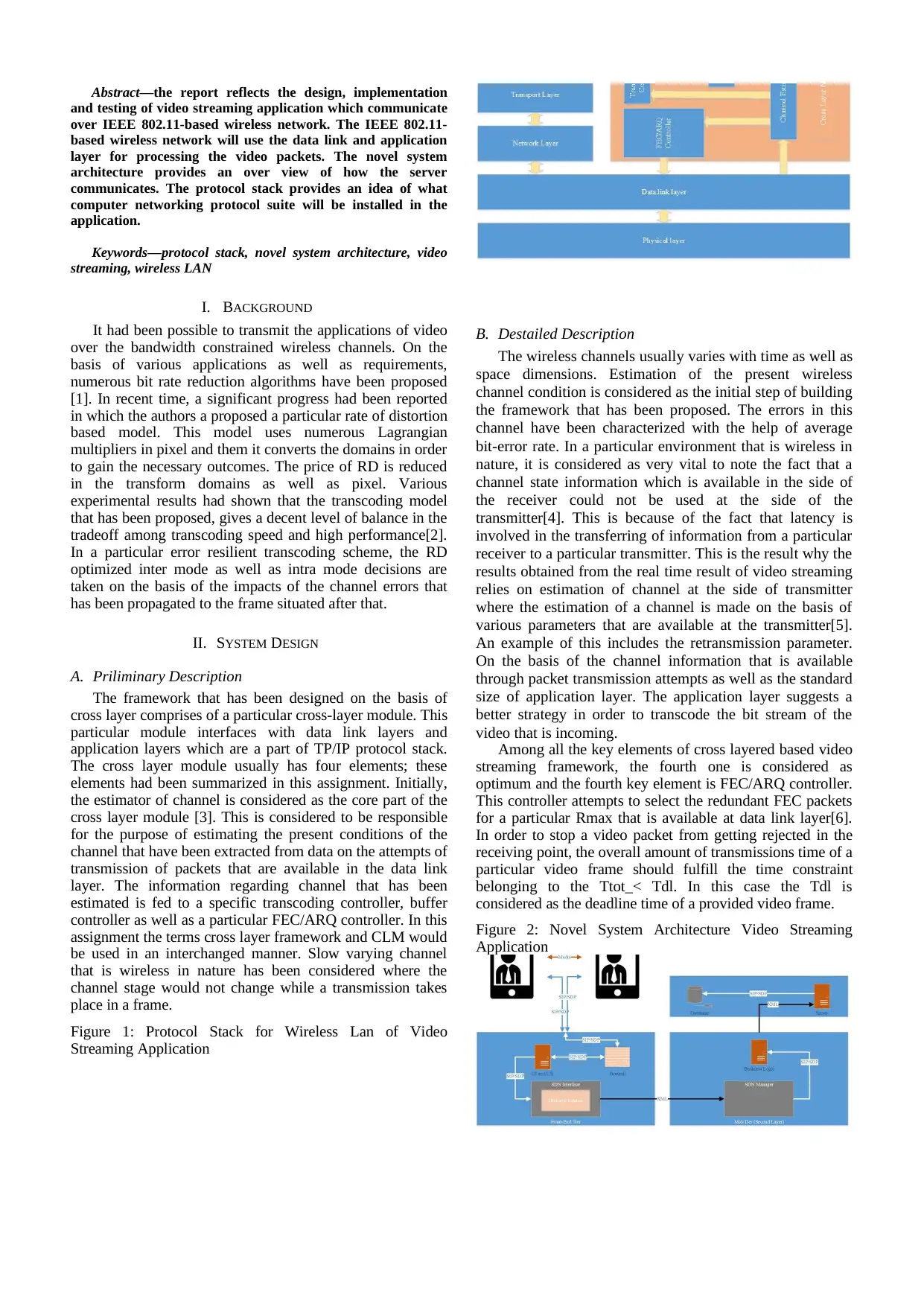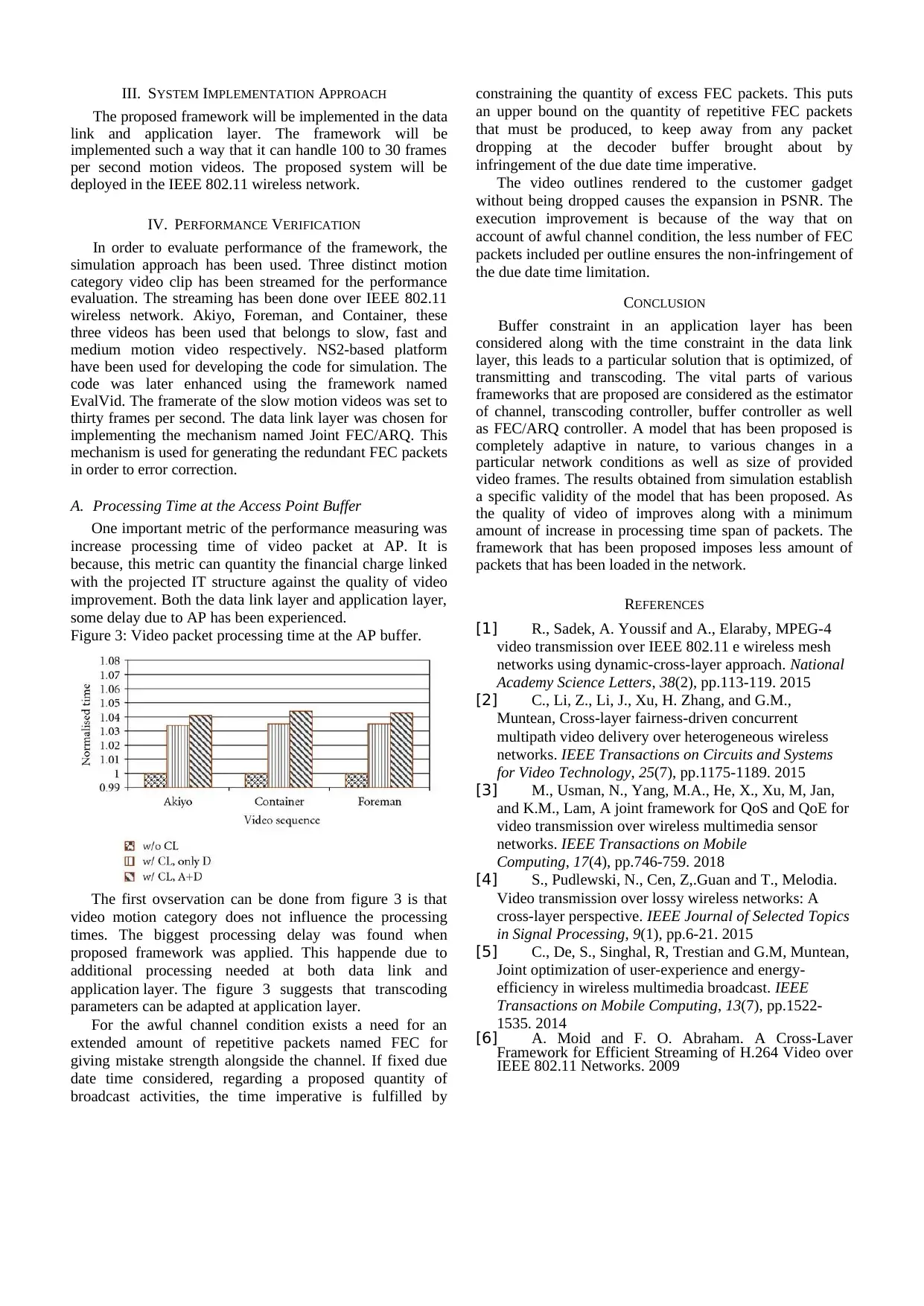Novel System Architecture and Protocol Stack for Video Streaming in Wireless LAN
VerifiedAdded on 2023/01/20
|4
|1737
|49
AI Summary
This report discusses the design, implementation, and testing of a video streaming application that communicates over an IEEE 802.11-based wireless network. It explores the novel system architecture and protocol stack used for efficient video streaming. The report also evaluates the performance of the framework through simulation and provides insights into the processing time and buffer constraints. The proposed system is implemented in the data link and application layer and is suitable for handling 100 to 30 frames per second motion videos in the IEEE 802.11 wireless network.
Contribute Materials
Your contribution can guide someone’s learning journey. Share your
documents today.

Computer Networking Assignment
Novel System Architecture and Protocol Stack for Video Streaming in Wireless LAN
Name of the student
Name of the University
Novel System Architecture and Protocol Stack for Video Streaming in Wireless LAN
Name of the student
Name of the University
Secure Best Marks with AI Grader
Need help grading? Try our AI Grader for instant feedback on your assignments.

Abstract—the report reflects the design, implementation
and testing of video streaming application which communicate
over IEEE 802.11-based wireless network. The IEEE 802.11-
based wireless network will use the data link and application
layer for processing the video packets. The novel system
architecture provides an over view of how the server
communicates. The protocol stack provides an idea of what
computer networking protocol suite will be installed in the
application.
Keywords—protocol stack, novel system architecture, video
streaming, wireless LAN
I. BACKGROUND
It had been possible to transmit the applications of video
over the bandwidth constrained wireless channels. On the
basis of various applications as well as requirements,
numerous bit rate reduction algorithms have been proposed
[1]. In recent time, a significant progress had been reported
in which the authors a proposed a particular rate of distortion
based model. This model uses numerous Lagrangian
multipliers in pixel and them it converts the domains in order
to gain the necessary outcomes. The price of RD is reduced
in the transform domains as well as pixel. Various
experimental results had shown that the transcoding model
that has been proposed, gives a decent level of balance in the
tradeoff among transcoding speed and high performance[2].
In a particular error resilient transcoding scheme, the RD
optimized inter mode as well as intra mode decisions are
taken on the basis of the impacts of the channel errors that
has been propagated to the frame situated after that.
II. SYSTEM DESIGN
A. Priliminary Description
The framework that has been designed on the basis of
cross layer comprises of a particular cross-layer module. This
particular module interfaces with data link layers and
application layers which are a part of TP/IP protocol stack.
The cross layer module usually has four elements; these
elements had been summarized in this assignment. Initially,
the estimator of channel is considered as the core part of the
cross layer module [3]. This is considered to be responsible
for the purpose of estimating the present conditions of the
channel that have been extracted from data on the attempts of
transmission of packets that are available in the data link
layer. The information regarding channel that has been
estimated is fed to a specific transcoding controller, buffer
controller as well as a particular FEC/ARQ controller. In this
assignment the terms cross layer framework and CLM would
be used in an interchanged manner. Slow varying channel
that is wireless in nature has been considered where the
channel stage would not change while a transmission takes
place in a frame.
Figure 1: Protocol Stack for Wireless Lan of Video
Streaming Application
B. Destailed Description
The wireless channels usually varies with time as well as
space dimensions. Estimation of the present wireless
channel condition is considered as the initial step of building
the framework that has been proposed. The errors in this
channel have been characterized with the help of average
bit-error rate. In a particular environment that is wireless in
nature, it is considered as very vital to note the fact that a
channel state information which is available in the side of
the receiver could not be used at the side of the
transmitter[4]. This is because of the fact that latency is
involved in the transferring of information from a particular
receiver to a particular transmitter. This is the result why the
results obtained from the real time result of video streaming
relies on estimation of channel at the side of transmitter
where the estimation of a channel is made on the basis of
various parameters that are available at the transmitter[5].
An example of this includes the retransmission parameter.
On the basis of the channel information that is available
through packet transmission attempts as well as the standard
size of application layer. The application layer suggests a
better strategy in order to transcode the bit stream of the
video that is incoming.
Among all the key elements of cross layered based video
streaming framework, the fourth one is considered as
optimum and the fourth key element is FEC/ARQ controller.
This controller attempts to select the redundant FEC packets
for a particular Rmax that is available at data link layer[6].
In order to stop a video packet from getting rejected in the
receiving point, the overall amount of transmissions time of a
particular video frame should fulfill the time constraint
belonging to the Ttot_< Tdl. In this case the Tdl is
considered as the deadline time of a provided video frame.
Figure 2: Novel System Architecture Video Streaming
Application
and testing of video streaming application which communicate
over IEEE 802.11-based wireless network. The IEEE 802.11-
based wireless network will use the data link and application
layer for processing the video packets. The novel system
architecture provides an over view of how the server
communicates. The protocol stack provides an idea of what
computer networking protocol suite will be installed in the
application.
Keywords—protocol stack, novel system architecture, video
streaming, wireless LAN
I. BACKGROUND
It had been possible to transmit the applications of video
over the bandwidth constrained wireless channels. On the
basis of various applications as well as requirements,
numerous bit rate reduction algorithms have been proposed
[1]. In recent time, a significant progress had been reported
in which the authors a proposed a particular rate of distortion
based model. This model uses numerous Lagrangian
multipliers in pixel and them it converts the domains in order
to gain the necessary outcomes. The price of RD is reduced
in the transform domains as well as pixel. Various
experimental results had shown that the transcoding model
that has been proposed, gives a decent level of balance in the
tradeoff among transcoding speed and high performance[2].
In a particular error resilient transcoding scheme, the RD
optimized inter mode as well as intra mode decisions are
taken on the basis of the impacts of the channel errors that
has been propagated to the frame situated after that.
II. SYSTEM DESIGN
A. Priliminary Description
The framework that has been designed on the basis of
cross layer comprises of a particular cross-layer module. This
particular module interfaces with data link layers and
application layers which are a part of TP/IP protocol stack.
The cross layer module usually has four elements; these
elements had been summarized in this assignment. Initially,
the estimator of channel is considered as the core part of the
cross layer module [3]. This is considered to be responsible
for the purpose of estimating the present conditions of the
channel that have been extracted from data on the attempts of
transmission of packets that are available in the data link
layer. The information regarding channel that has been
estimated is fed to a specific transcoding controller, buffer
controller as well as a particular FEC/ARQ controller. In this
assignment the terms cross layer framework and CLM would
be used in an interchanged manner. Slow varying channel
that is wireless in nature has been considered where the
channel stage would not change while a transmission takes
place in a frame.
Figure 1: Protocol Stack for Wireless Lan of Video
Streaming Application
B. Destailed Description
The wireless channels usually varies with time as well as
space dimensions. Estimation of the present wireless
channel condition is considered as the initial step of building
the framework that has been proposed. The errors in this
channel have been characterized with the help of average
bit-error rate. In a particular environment that is wireless in
nature, it is considered as very vital to note the fact that a
channel state information which is available in the side of
the receiver could not be used at the side of the
transmitter[4]. This is because of the fact that latency is
involved in the transferring of information from a particular
receiver to a particular transmitter. This is the result why the
results obtained from the real time result of video streaming
relies on estimation of channel at the side of transmitter
where the estimation of a channel is made on the basis of
various parameters that are available at the transmitter[5].
An example of this includes the retransmission parameter.
On the basis of the channel information that is available
through packet transmission attempts as well as the standard
size of application layer. The application layer suggests a
better strategy in order to transcode the bit stream of the
video that is incoming.
Among all the key elements of cross layered based video
streaming framework, the fourth one is considered as
optimum and the fourth key element is FEC/ARQ controller.
This controller attempts to select the redundant FEC packets
for a particular Rmax that is available at data link layer[6].
In order to stop a video packet from getting rejected in the
receiving point, the overall amount of transmissions time of a
particular video frame should fulfill the time constraint
belonging to the Ttot_< Tdl. In this case the Tdl is
considered as the deadline time of a provided video frame.
Figure 2: Novel System Architecture Video Streaming
Application

III. SYSTEM IMPLEMENTATION APPROACH
The proposed framework will be implemented in the data
link and application layer. The framework will be
implemented such a way that it can handle 100 to 30 frames
per second motion videos. The proposed system will be
deployed in the IEEE 802.11 wireless network.
IV. PERFORMANCE VERIFICATION
In order to evaluate performance of the framework, the
simulation approach has been used. Three distinct motion
category video clip has been streamed for the performance
evaluation. The streaming has been done over IEEE 802.11
wireless network. Akiyo, Foreman, and Container, these
three videos has been used that belongs to slow, fast and
medium motion video respectively. NS2-based platform
have been used for developing the code for simulation. The
code was later enhanced using the framework named
EvalVid. The framerate of the slow motion videos was set to
thirty frames per second. The data link layer was chosen for
implementing the mechanism named Joint FEC/ARQ. This
mechanism is used for generating the redundant FEC packets
in order to error correction.
A. Processing Time at the Access Point Buffer
One important metric of the performance measuring was
increase processing time of video packet at AP. It is
because, this metric can quantity the financial charge linked
with the projected IT structure against the quality of video
improvement. Both the data link layer and application layer,
some delay due to AP has been experienced.
Figure 3: Video packet processing time at the AP buffer.
The first ovservation can be done from figure 3 is that
video motion category does not influence the processing
times. The biggest processing delay was found when
proposed framework was applied. This happende due to
additional processing needed at both data link and
application layer. The figure 3 suggests that transcoding
parameters can be adapted at application layer.
For the awful channel condition exists a need for an
extended amount of repetitive packets named FEC for
giving mistake strength alongside the channel. If fixed due
date time considered, regarding a proposed quantity of
broadcast activities, the time imperative is fulfilled by
constraining the quantity of excess FEC packets. This puts
an upper bound on the quantity of repetitive FEC packets
that must be produced, to keep away from any packet
dropping at the decoder buffer brought about by
infringement of the due date time imperative.
The video outlines rendered to the customer gadget
without being dropped causes the expansion in PSNR. The
execution improvement is because of the way that on
account of awful channel condition, the less number of FEC
packets included per outline ensures the non-infringement of
the due date time limitation.
CONCLUSION
Buffer constraint in an application layer has been
considered along with the time constraint in the data link
layer, this leads to a particular solution that is optimized, of
transmitting and transcoding. The vital parts of various
frameworks that are proposed are considered as the estimator
of channel, transcoding controller, buffer controller as well
as FEC/ARQ controller. A model that has been proposed is
completely adaptive in nature, to various changes in a
particular network conditions as well as size of provided
video frames. The results obtained from simulation establish
a specific validity of the model that has been proposed. As
the quality of video of improves along with a minimum
amount of increase in processing time span of packets. The
framework that has been proposed imposes less amount of
packets that has been loaded in the network.
REFERENCES
[1] R., Sadek, A. Youssif and A., Elaraby, MPEG-4
video transmission over IEEE 802.11 e wireless mesh
networks using dynamic-cross-layer approach. National
Academy Science Letters, 38(2), pp.113-119. 2015
[2] C., Li, Z., Li, J., Xu, H. Zhang, and G.M.,
Muntean, Cross-layer fairness-driven concurrent
multipath video delivery over heterogeneous wireless
networks. IEEE Transactions on Circuits and Systems
for Video Technology, 25(7), pp.1175-1189. 2015
[3] M., Usman, N., Yang, M.A., He, X., Xu, M, Jan,
and K.M., Lam, A joint framework for QoS and QoE for
video transmission over wireless multimedia sensor
networks. IEEE Transactions on Mobile
Computing, 17(4), pp.746-759. 2018
[4] S., Pudlewski, N., Cen, Z,.Guan and T., Melodia.
Video transmission over lossy wireless networks: A
cross-layer perspective. IEEE Journal of Selected Topics
in Signal Processing, 9(1), pp.6-21. 2015
[5] C., De, S., Singhal, R, Trestian and G.M, Muntean,
Joint optimization of user-experience and energy-
efficiency in wireless multimedia broadcast. IEEE
Transactions on Mobile Computing, 13(7), pp.1522-
1535. 2014
[6] A. Moid and F. O. Abraham, A Cross-Layer
Framework for Efficient Streaming of H.264 Video over
IEEE 802.11 Networks. 2009
The proposed framework will be implemented in the data
link and application layer. The framework will be
implemented such a way that it can handle 100 to 30 frames
per second motion videos. The proposed system will be
deployed in the IEEE 802.11 wireless network.
IV. PERFORMANCE VERIFICATION
In order to evaluate performance of the framework, the
simulation approach has been used. Three distinct motion
category video clip has been streamed for the performance
evaluation. The streaming has been done over IEEE 802.11
wireless network. Akiyo, Foreman, and Container, these
three videos has been used that belongs to slow, fast and
medium motion video respectively. NS2-based platform
have been used for developing the code for simulation. The
code was later enhanced using the framework named
EvalVid. The framerate of the slow motion videos was set to
thirty frames per second. The data link layer was chosen for
implementing the mechanism named Joint FEC/ARQ. This
mechanism is used for generating the redundant FEC packets
in order to error correction.
A. Processing Time at the Access Point Buffer
One important metric of the performance measuring was
increase processing time of video packet at AP. It is
because, this metric can quantity the financial charge linked
with the projected IT structure against the quality of video
improvement. Both the data link layer and application layer,
some delay due to AP has been experienced.
Figure 3: Video packet processing time at the AP buffer.
The first ovservation can be done from figure 3 is that
video motion category does not influence the processing
times. The biggest processing delay was found when
proposed framework was applied. This happende due to
additional processing needed at both data link and
application layer. The figure 3 suggests that transcoding
parameters can be adapted at application layer.
For the awful channel condition exists a need for an
extended amount of repetitive packets named FEC for
giving mistake strength alongside the channel. If fixed due
date time considered, regarding a proposed quantity of
broadcast activities, the time imperative is fulfilled by
constraining the quantity of excess FEC packets. This puts
an upper bound on the quantity of repetitive FEC packets
that must be produced, to keep away from any packet
dropping at the decoder buffer brought about by
infringement of the due date time imperative.
The video outlines rendered to the customer gadget
without being dropped causes the expansion in PSNR. The
execution improvement is because of the way that on
account of awful channel condition, the less number of FEC
packets included per outline ensures the non-infringement of
the due date time limitation.
CONCLUSION
Buffer constraint in an application layer has been
considered along with the time constraint in the data link
layer, this leads to a particular solution that is optimized, of
transmitting and transcoding. The vital parts of various
frameworks that are proposed are considered as the estimator
of channel, transcoding controller, buffer controller as well
as FEC/ARQ controller. A model that has been proposed is
completely adaptive in nature, to various changes in a
particular network conditions as well as size of provided
video frames. The results obtained from simulation establish
a specific validity of the model that has been proposed. As
the quality of video of improves along with a minimum
amount of increase in processing time span of packets. The
framework that has been proposed imposes less amount of
packets that has been loaded in the network.
REFERENCES
[1] R., Sadek, A. Youssif and A., Elaraby, MPEG-4
video transmission over IEEE 802.11 e wireless mesh
networks using dynamic-cross-layer approach. National
Academy Science Letters, 38(2), pp.113-119. 2015
[2] C., Li, Z., Li, J., Xu, H. Zhang, and G.M.,
Muntean, Cross-layer fairness-driven concurrent
multipath video delivery over heterogeneous wireless
networks. IEEE Transactions on Circuits and Systems
for Video Technology, 25(7), pp.1175-1189. 2015
[3] M., Usman, N., Yang, M.A., He, X., Xu, M, Jan,
and K.M., Lam, A joint framework for QoS and QoE for
video transmission over wireless multimedia sensor
networks. IEEE Transactions on Mobile
Computing, 17(4), pp.746-759. 2018
[4] S., Pudlewski, N., Cen, Z,.Guan and T., Melodia.
Video transmission over lossy wireless networks: A
cross-layer perspective. IEEE Journal of Selected Topics
in Signal Processing, 9(1), pp.6-21. 2015
[5] C., De, S., Singhal, R, Trestian and G.M, Muntean,
Joint optimization of user-experience and energy-
efficiency in wireless multimedia broadcast. IEEE
Transactions on Mobile Computing, 13(7), pp.1522-
1535. 2014
[6] A. Moid and F. O. Abraham, A Cross-Layer
Framework for Efficient Streaming of H.264 Video over
IEEE 802.11 Networks. 2009

1 out of 4
Your All-in-One AI-Powered Toolkit for Academic Success.
+13062052269
info@desklib.com
Available 24*7 on WhatsApp / Email
![[object Object]](/_next/static/media/star-bottom.7253800d.svg)
Unlock your academic potential
© 2024 | Zucol Services PVT LTD | All rights reserved.